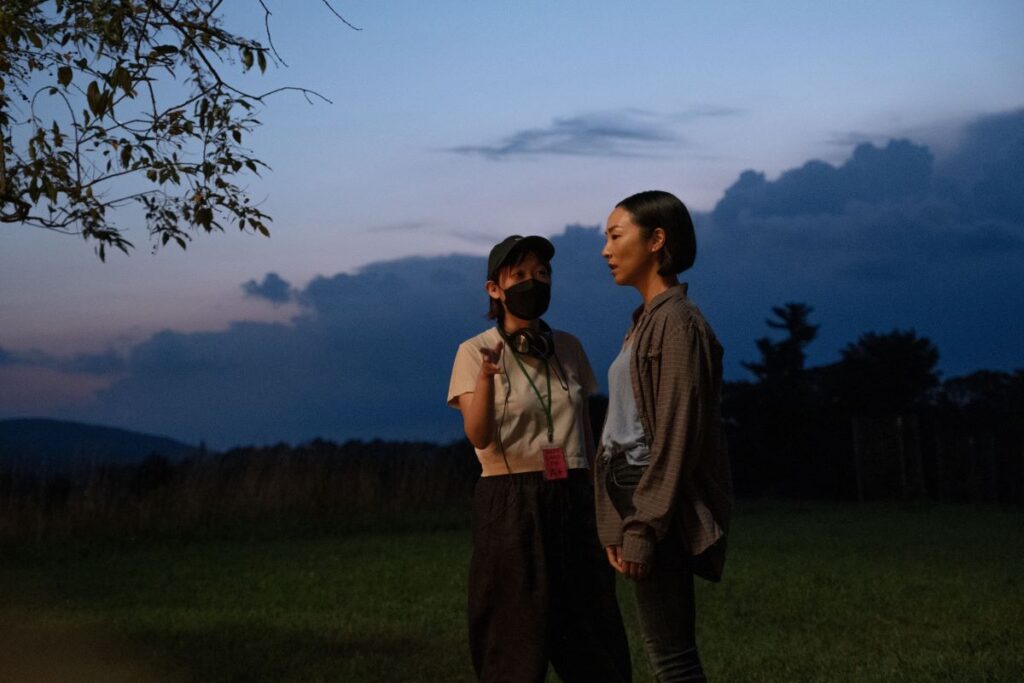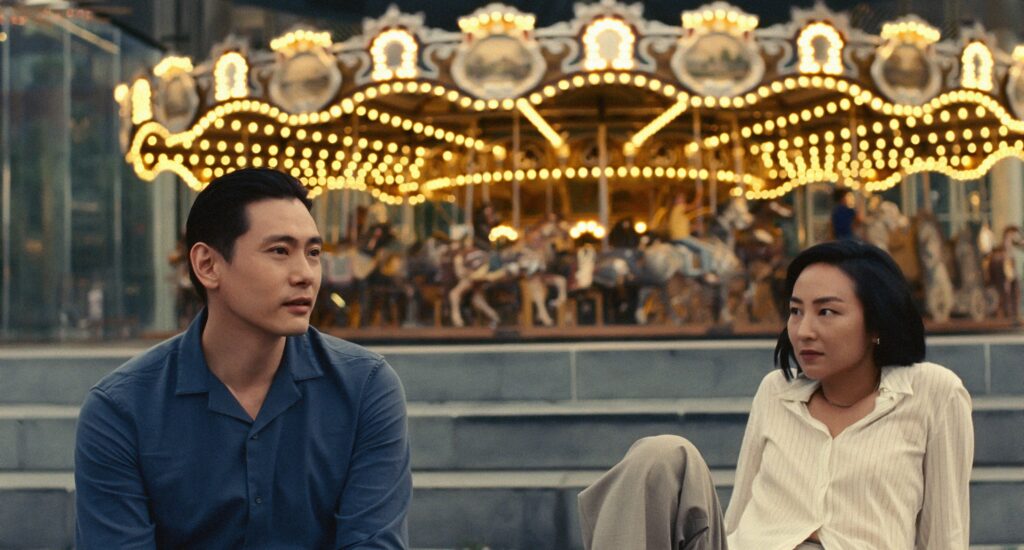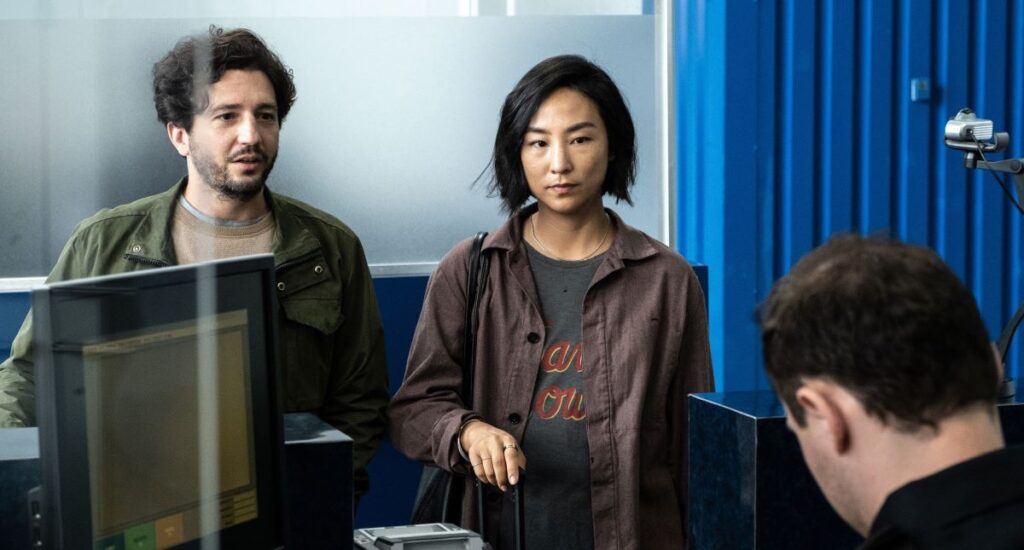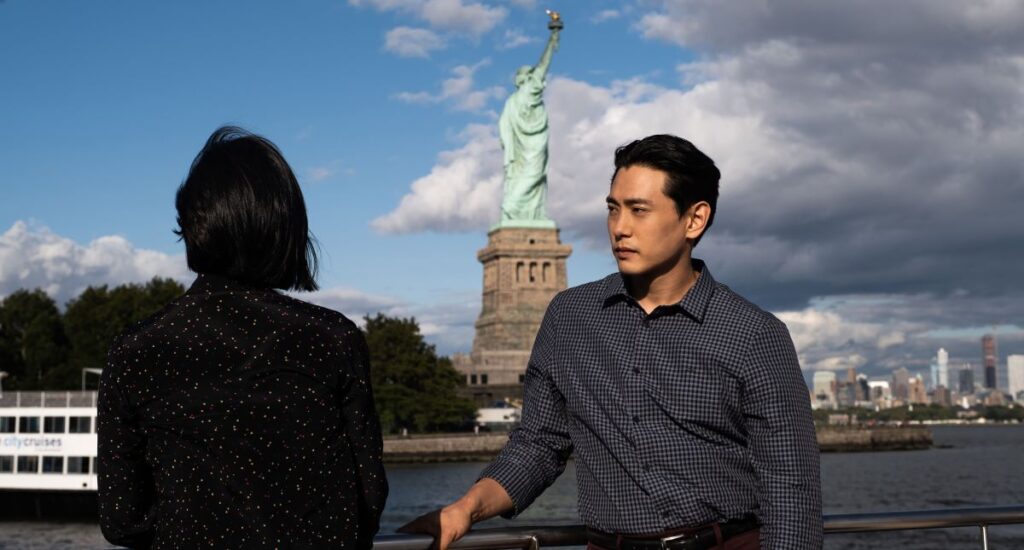
Past Lives begins with a pivotal scene: Nora (Greta Lee) is sitting between Hae Sung (Teo Yoo) and Arthur (John Magaro) at a bar. They appear to be having a conversation with each other, but the voiceovers we hear are commentaries from off-screen strangers presuming to be at the same bar: How do they know each other? Are the two Asians dating and the white guy a tour guide? Is Nora a hired translator between Hae Sung and Arthur? Are they all friends? Suddenly, Nora coyly faces the camera, which has been slowly zooming in on the three.
In describing the scene, I realize it sounds like a dreamy in medias res (more modernly recognized as the record-scratch “You’re probably wondering how I ended up in this situation” intro). However, what might appear on script doesn’t come close to the experience of seeing the film depicted in dimensions farther beyond words. Playwright Celine Song, who had her work “Endlings” premiere at the A.R.T. Center in 2019, breaks into the film world with her debut, Past Lives, a film that has rightfully generated acclaim at Sundance and the Berlin International Film Festival (as well as the Independent Film Festival Boston). After the bar scene, the story begins with Nora and Hae Sung as children in South Korea, who compare math scores on their walk home and goof around on museum grounds. Nora’s family then moves to America, cutting off communication between the two for years. We next find them as adults in a sort of transitional phase: Nora is finishing college to pursue writing while Hae Sung is a sort of company man after completing mandatory military service. He finds Nora on Facebook, where they begin to reconnect through hours of Skype conversations.
One of the biggest delusions that Past Lives thwarts is propelling a specific narrative path for two characters. Nora and Hae Sung share the same language and experiences, but when we see Nora’s husband Arthur enter into the movie, we truly wonder where this is heading. This specific narrative, in which two people are meant to be together at the end, is shattered by Song’s intentions to make a love story expansive beyond two characters and the time limits of our lives. “In-yun,” which is the connection that begins with two strangers and follows them over the course of their lives, recurs in conversations between the three characters. Regardless of the film’s technical conclusion, there is not really an ending.
Ahead of its release on June 9, we spoke with director and writer Song about the film’s visual language, Skype flashbacks, and the integration of art and history.
The conversation has been edited and condensed for clarity.
BOSTON HASSLE: It’s your first time making a film. I was wondering if you knew that you wanted to make a film first or if you wrote the script and then saw that it had to be a film.
CELINE SONG: I was conceiving of it as a film because it’s hard to tell a story that spans decades and continents. It also had to show aging. You do want to see these people as children and then at different parts of life. Film really felt like the kind of medium that was better suited. The other thing was also wanting to depict the cities since they’re connected to the characters. Hae Sung is from Seoul and Nora is from New York, which matters. I really wanted to pick the places that they live because of how different those places are and what makes these two characters different.

BH: I found the movie to be so cinematically romantic. Even if you didn’t hear anything that they were saying, you could tell that there was a lot of emotion in its environment. I was wondering if there were any movies that inspired you during filming or writing.
CS: Something that I wanted was to not treat the film as an homage to a movie that already exists. What I really wanted was for the visual language to speak for itself, walk on its own, and have its own beat. I try not to think of other movies holistically as a way to replicate since I wanted (Past Lives) to be unique. But of course, I’m pulling images and ideas from other movies — My Dinner with Andre, for example, was something I proposed as being something great for the bar scene. It’s the penultimate scene where so much is hashed out but it’s also nothing. It’s not an action sequence, it’s not a hugely visually complicated sequence in appearance. My Dinner with Andre has offered something amazing where they’re able to hold this conversation and you’re somehow sitting on the edge of your seat. And before you know it, you’re just lost in the conversation and at some point, you just slip into the deep end. That happens without warning. I was thinking about that movie in terms of how to replicate that feeling because that conversation (in the bar) has to slip through so that it gets deep.
BH: Going back to how it speaks as a visual language, one thing I found particularly masterful was the lighting. In the beginning, it was a functionality where you needed the light and dark because of the different time zones. But then I thought it helped bring forth the emotions that were unsaid. Like when they were breaking it off in their Skype conversation, you can see that Hae Sung is kinda receding in the darkness. I was wondering if that was part of the great blueprint to have the visual parts speak for the characters.
CS: Yes, I think that was the only thing that my DP (Shabier Kirchner) and I were concerned with. Creating beautiful images was not the most important goal, although I think we did end up creating a lot. Shabier and I were talking about how, yes, that’s pretty, but how is this connected to the characters and story? When it came to lighting, it was always a dramaturgical conversation more than an aesthetic conversation. Day and night has to work in this way when it speaks to something more practical. In the Skype sequence when they’re in two different places and breaking up, what we wanted was for the sun to set on one side and the sun to rise on the other side. Whatever the time zones are, it’s possible for those two things to be happening at the same time as (Hae Sung is) transitioning out of the light in this part of the story. We wanted this conversation in the dark because suddenly, he’s a mystery to Nora. We can see his emotional reaction but we have to leave him in the dark because when you see it through Nora’s screen, you wouldn’t be able to see his expression. Part of this is Nora closing the door and making the decision to not to get to know Hae Sung anymore. And on her end, the sun is rising, (which is right before) she goes to go to this magical place where she meets her husband.
BH: You got the Skype aspect accurately. I feel like people don’t remember that there weren’t any ring lights and that webcams were (of) lesser quality.
CS: They were so bad! I think it’s so funny because we built two physical sets and we were actually connecting those two rooms with a physical cable and put a throttle on it. We were controlling how bad the connection was because I kept saying that it had to be frustrating.
That’s what’s amazing about technology, right? There’s a part of this movie that’s a little bit sci-fi because, in a way, our lives are sci-fi. I remember when (Skype) first started happening, we were like, “I can’t believe I can have a full conversation with another person over the screen! It’s amazing, it’s a miracle.” When they see each other for the first time in 12 years (on Skype), it is so magical and completely unreal. But with their growing intimacy, you start to resent the technology part because it starts to not be good enough. Over time, you want more physicality. What felt miraculous before suddenly feels like an annoying thing. That’s what I wanted to represent. I needed the connection to be frustrating and freeze and for (the screen) to be in different colors all the time so that it feels tangible and real.

BH: In addition to the Skype experience, I know that the movie is based on a personal experience. Did you feel like you had a hard time balancing the story that you wanted to tell and how much you wanted to share?
CS: I really only focused on telling the story that I wanted to tell more than anything. I think that that really wasn’t the art of the pursuit so I feel like I worried less about that part because I knew that the story was going to speak for itself.
BH: I was curious about the statues that we see the kids play around in the beginning of the movie. Is that in South Korea?
CS: Yeah, it’s in South Korea. It’s at the Gwacheon Modern Museum. I think it’s called “The New Gazing of Being.” Let me check. (Song tries to find the name online.)
BH: I was having a hard time finding it. I remember the statue where there was a man —
CS: “The Singing Man”!
BH: Yeah! I was trying to find it and couldn’t really find the right keywords but it could be just me.
CS: No, I think it is hard to find. These are not museums where you have full access to the catalog.
BH: How did you pick that place? Was it something that you knew from childhood or something you found on location?
CS: Because it had to represent the ‘90s, we wanted to go to an outdoor museum where the artwork would still be from the ‘90s. I wanted it to be a modern art museum because I initially was going to have Hae Sung and Nora to meet at the MoMA for the first time in New York City instead of Madison Square Park.

BH: Right before this interview, I was thinking about how the Statue of Liberty came into the story. I don’t know if there was supposed to be a guessing game on who she would end up with at the end. But that scene where she’s taking pictures of him with the Statue in the background — that was telling. To me, it spoke in contrast to when they were kids playing around the (South Korean) statue. Did (the Statue of Liberty) have any significance for you?
CS: The Statue of Liberty is not a romantic place for New Yorkers, but it is for immigrants and tourists. I don’t think that every movie shot in New York should have the Statue of Liberty but in this one, it needed to be because it is about an immigrant and tourist and for them, the Statue has such philosophical significance, which I feel like that’s really at the heart of it. You’re right: (in the beginning), they’re in front of this piece of art in Korea that’s hard to find. The name escapes even me. And now, they’re on a boat looking at one of the most famous statues on Earth.
BH: You’ve hit an emotional home run with this movie. In terms of what you want to do next, do you find yourself again in this genre? Do you like making people cry? Do you want to keep making films?
CS: Oh, I want to keep making movies. I think with every movie that I make, there has to be something that is different from the ones before. It’s less (about) genre — or maybe I want to do a completely new genre. It’s a little more like I need to really believe that the new thing I’m doing is something that I personally haven’t done before for myself, whatever that means. In some ways, that might be more about the technical or maybe it might be a theme. At the end of the day, everything I do — I’m gonna feel personally connected to it.
Past Lives
2023
dir. Celine Song
106 min.
Opens Friday, 6/9 @ Kendall Square Cinema and AMC Boston Common

